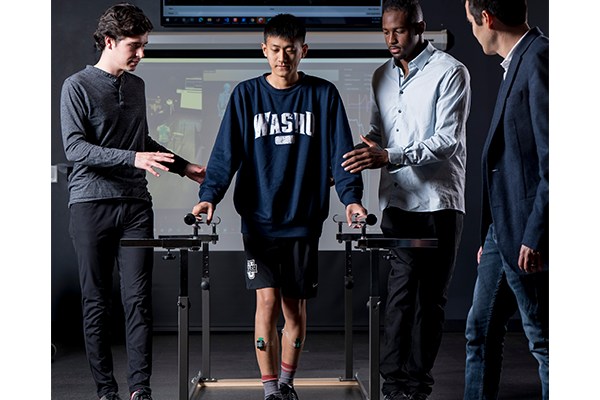Restoring movement after spinal cord injury focus of new research
Ismael Seáñez's lab to work with interdisciplinary team

People with spinal cord injuries often experience life-long movement impairment or paralysis, for which there is no cure. When coupled with rehabilitative exercise, electrical spinal cord stimulation can help restore some movement, though the mechanisms of how the nerves in the spinal cord recover are unknown.
Ismael Seáñez, assistant professor of biomedical engineering in the McKelvey School of Engineering at Washington University in St. Louis, will lead an interdisciplinary team of Washington University researchers and physicians to understand the changes in the neural circuits that may result in motor function improvements through using spinal cord stimulation with a five-year, $1 million grant from the National Institutes of Health’s National Institute of Neurological Disorders and Stroke.
Seáñez, also an assistant professor of neurological surgery at the School of Medicine, plans to begin a clinical trial with patients with spinal cord injuries as well as those without spinal cord injuries as controls. He will use commercially available, noninvasive spinal cord stimulation devices that engage movement in the patients with spinal cord injury to determine how the central nervous system changes with the stimulation and movement.
While the spinal cord stimulation devices are attached externally by the patient or a caregiver, they only work when attached to the patient, so any movement that might take place while the devices are attached cannot be repeated when they are removed, Seáñez said.
“We’ve been first working on optimizing the way we can stimulate the spinal cord and using different stimulation parameters to more selectively target different muscle groups to look at how the stimulation interacts with the brain,” he said. “Now, we are looking at how the pathways are changing and whether different exercises used in physical therapy can accelerate the excitement of different neuropathways,” Seáñez said.
Seáñez will collaborate with a strong, interdisciplinary team, including:
- Rita Haddad, instructor in psychiatry;
- Neringa Juknis, MD, associate professor of neurology;
- Catherine Lang, professor of physical therapy, of neurology and of occupational therapy;
- Eric Leuthardt, MD, professor of neurosurgery and of neuroscience in the School of Medicine and of biomedical engineering and mechanical engineering & materials science in McKelvey Engineering;
- Dan Moran, professor of biomedical engineering;
- Kerri Morgan, assistant professor of occupational therapy and of neurology;
- Theresa C. Notestine, manager, clinical practice, Department of Physical Therapy;
- Brenton H. Pennicooke, MD, assistant professor of neurological surgery and of orthopedic surgery;
- Monica A. Perez, scientific chair, Arms + Hands Lab, Shirley Ryan AbilityLab and professor of physical medicine and rehabilitation at Northwestern University
- Wilson (Zack) Ray, MD, professor of neurosurgery




